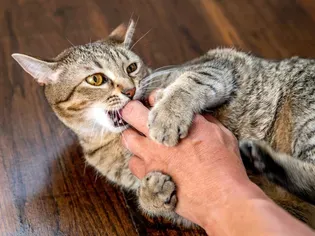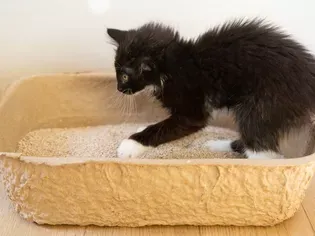How to Stop Cats From Biting and Scratching
Updated on 05/27/24

[Headline]: End the Battle: Unlocking the Secrets to Curb Cat Biting and Scratching
Introduction:
Every feline enthusiast knows that while cats are delightful companions, their sharp claws and teeth can be a cause for concern. Whether it's an occasional playful nip or an unexpected scratch, these behaviors can be painful and even lead to infection. Fear not, fellow cat lovers! This comprehensive guide will equip you with proven strategies to effectively stop your feline friend from biting and scratching, restoring harmony to your household.
Section 1: Understanding the Causes
* Play Aggression: This is the most common reason for biting and scratching. Cats often express their excitement or boredom through play, which can involve biting and scratching.
* Fear or Anxiety: When a cat feels threatened or scared, it may resort to biting or scratching as a defensive mechanism.
* Redirection Aggression: This occurs when a cat redirects pent-up aggression or frustration onto another target, such as you.
* Overstimulation: Excessive petting or grooming can overstimulate cats, leading to biting or scratching.
* Medical Issues: Underlying medical conditions, such as pain or hormonal imbalances, can also contribute to aggressive behavior.
Section 2: Preventing and Redirecting Aggression
* Provide Ample Playtime: Engage your cat in regular playtime to release its pent-up energy and satisfy its natural hunting instincts. Use interactive toys, such as wands with feathers or laser pointers, to encourage chasing and pouncing.
* Establish Clear Boundaries: Teach your cat that biting and scratching are unacceptable behaviors. When your cat bites or scratches, immediately say "no" or "ouch" in a firm but calm voice.
* Redirect to Appropriate Toys: If your cat bites or scratches during playtime, gently redirect it to an appropriate toy that it can scratch or bite.
* Respect Your Cat's Space: Learn your cat's body language and avoid petting or grooming it when it shows signs of discomfort, such as flattening its ears or swishing its tail.
Section 3: Addressing Fear and Anxiety
* Provide a Safe and Secure Environment: Create a calming and stress-free environment for your cat. Provide plenty of hiding places, such as cat trees or covered boxes, where it can retreat when feeling overwhelmed.
* Identify Triggers: Determine what triggers your cat's fear or anxiety. It could be loud noises, strangers, or other animals. Once you know the triggers, try to avoid or gradually desensitize your cat to them.
* Use Calming Aids: Pheromone diffusers or sprays can help create a calming atmosphere for anxious cats. Consider consulting with your veterinarian about other anti-anxiety medications if necessary.
Section 4: Managing Redirection Aggression
* Identify the Source of Aggression: Determine what is triggering your cat's redirection aggression. It could be a specific person, object, or situation.
* Block Access to the Trigger: If possible, remove or restrict your cat's access to the trigger.
* Provide a Safe Outlet: Offer your cat an alternative outlet for its aggression, such as a scratching post or interactive toy.
* Counter-Conditioning: Gradually pair the trigger with something positive, such as treats or playtime. This helps your cat associate the trigger with something enjoyable rather than negative.
Section 5: Ruling Out Medical Issues
* Consult Your Veterinarian: If your cat's biting or scratching is a sudden or unexplained change in behavior, it's essential to consult your veterinarian. Underlying medical issues, such as pain, allergies, or hormonal imbalances, can cause these behaviors.
* Medical Treatment: If your veterinarian diagnoses a medical condition, follow their treatment recommendations. This may involve pain medication, allergy shots, or hormone therapy.
Section 6: Additional Tips
* Be Patient and Consistent: Changing your cat's behavior takes time and consistency. Be patient with your furry friend and consistently apply the recommended strategies.
* Seek Professional Help: If you're struggling to curb your cat's biting or scratching, consider seeking professional help from a certified animal behaviorist or veterinarian.
* Reward Positive Behavior: When your cat exhibits appropriate behavior, such as playing gently or avoiding biting and scratching, reward it with treats, praise, or playtime.
Conclusion:
With determination, patience, and the strategies outlined in this guide, you can effectively stop your cat from biting and scratching. By understanding the causes, preventing aggression, addressing fear and anxiety, and ruling out medical issues, you can restore harmony to your feline-human relationship. Remember, every cat is different, so finding the combination of techniques that works best for your furry companion is key. With love and dedication, you can transform biting and scratching from a nuisance into a thing of the past, allowing you to fully embrace the joys of feline companionship.
Explore More Pets

Cat Behavior Problems
How to Stop Aggression in Kittens

Long-Haired Cat Breeds
Siberian Cat: Breed Profile, Characteristics, & Care

Cat Behavior Problems
How to Stop Kittens From Scratching and Biting

Long-Haired Cat Breeds
Turkish Angora: Cat Breed Profile, Characteristics & Care

Basic Training
How to Socialize Your Kitten

Short-Haired Cat Breeds
Cute Pictures & Facts About Calico Cats & Kittens

Litter Box Training
Training Your Kitten to Use the Litter Box

Long-Haired Cat Breeds
10 Fun Facts About White Cats
